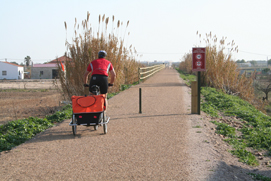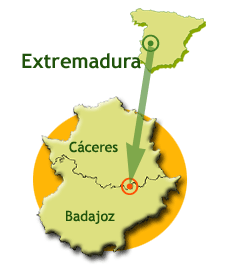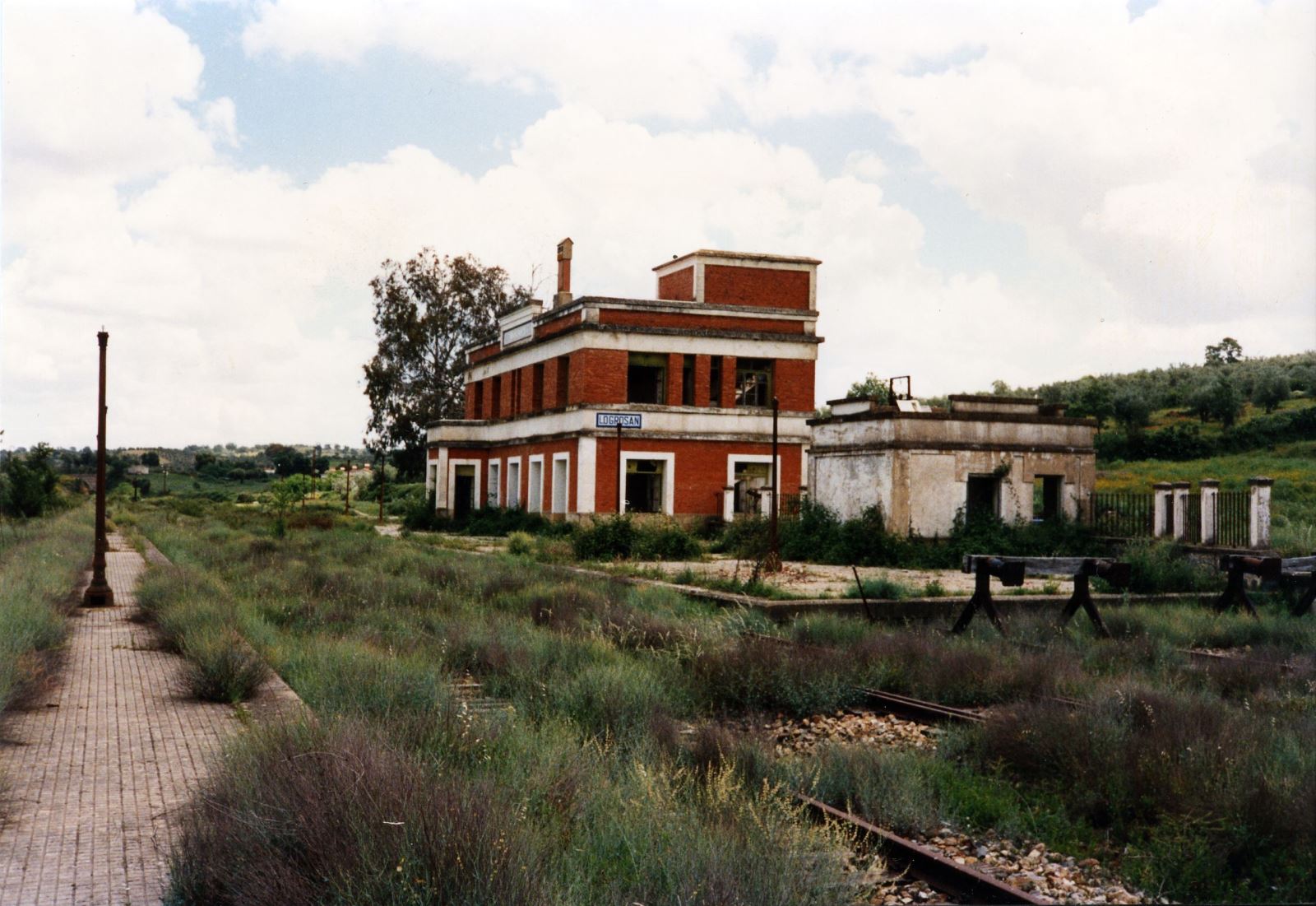|
 Back to index Back to index
|
| Itineraries > Vegas Guadiana Greenway |
|
|

|
Halfway between the provinces of Badajoz and Cáceres, this greenway goes from the plain rice field to the mountais full of grassland.
|
| WRITE YOUR REVIEW
|
| Technical Data
|
|
 CONDITIONED GREENWAY CONDITIONED GREENWAY
|
LOCATION
Between Logrosán (Cáceres) end Villanueva de la Serena (Badajoz)
Cáceres and Badajoz. Extremadura
Municipalities: Villanueva de la Serena, Don Benito, Rena, Villar de Rena, Torviscal, Palazuelo (Villar de Rena), Madrigalejo, Campo Lugar, Navalvillar de la Pela, Logrosán
Length: 57,70 km
|
|
 |
|
Cultural heritage:
Villanueva de la Serena: Church of the Assumption and castle of La Encomienda
Rena: Church of Los Angeles
Villar de Rena: Church of San Pedro Apóstol
Madrigalejo: Church of San Juan Bautista, hermitage of Las Angustias, Roman remains and Casa de Santa María
Campo Lugar: Church of the Angels and Roman fountain
Navalvillar de Pela: Hermitage of Caridad and church of Santa Catalina
Logrosán: Mines of Logrosán (Costanaza Mine and Interpretation Center), San Mateo Church, Virgen del Consuelo hermitage, Ethnographic Museum, Geological and Mining Museum
Infrastructure:
Continuous greenway. 3 viaducts
How to get there:
Public transport: Villanueva de la Serena. Renfe (train) and La Sepulvedana buses
Connections:
Cáceres: 94 Km
Mérida: 94 Km
Madrid: 241 Km
Connections with other routes/Greenways:
This Greenway connects with the Jara Greenway through the Natural Path of The Villuercas and with the Guadiana Natural Path
|
|
|
|
| Description
|
|
The Vegas del Guadiana Greenway begins at Villanueva de la Serena Train Station and runs towards the tanks that supply the locality and Ronda de la Hispanidad with drinking water.
Beside the flyover on the road to Don Benito (Ronda de la Hispanidad), the Madrid-Badajoz railway line and the Villanueva de la Serena-Talavera railway line, whose building work was never completed, split. This point (marked as “km 1”), which features a rest area, is where the greenway begins and acquires its characteristic appearance.
Leaving Villanueva de la Serena behind, the greenway turns right and enters a deep, damp red-coloured railway trench. This section crosses the Zújar canal and its parallel road (km 2.3). However, the linearity of the railway route is interrupted by a wide, compact dirt track crossing it (km 5). Since the impassable railway platform is overgrown with undergrowth, the greenway abandons the original railway route, turns right and continues along this dirt track, sharing an unchanging landscape with other vehicles. Without leaving the dirt trail, we come to a second transversal trail: the left branch takes us to a level crossing with the busy BA-060 road (km 6.3).
On the other side of the road, the dirt trail becomes an asphalt road leading up to the hill called El Ventorrillo. Here an impressive panoramic view opens up before us. The greenway goes down a steep slope towards the Guadiana, enabling us to see the striking viaducts that, supported by aesthetic concrete arches fastened to robust pillars, cross the large river. The descent and asphalt end when we reach the first iron viaduct (km 7), connecting once again with the original railway route. Here the section shared by other vehicles also ends and there begins a section supported by three tall viaducts, which are extended by means of a tall embankment.
The almost aerial section above the plain of the Guadiana ends at an underpass below the N-430 road (km 8.2), leading to an open landscape made up entirely of farmland. At km 9.6, the ruinous Rena Station appears and, further on, its loading bay crowned by stork nests, the first of many along the way.
After passing the station, the greenway ascends alongside rows of fruit trees on both sides, gradually becoming an embankment leading to the bridge over the Gargáligas River (km 10,4); this setting is shared by anglers and birds, featuring a bird-ringing station. At km 13, a flyover rises up on the road leading to the district of El Torviscal, about 300 m from the greenway; and at km 17, another flyover appears, after which the silhouette of the locality of Palazuelo filters thorough a green tapestry, formed by the black poplars and eucalyptus trees populating the banks of the Ruecas River.
At around km 19, the greenway enters the province of Caceres and we come across Campo Lugar Station. The striking and ghostly brick passenger building still has a certain elegance. The roofless depot is decorated with stork nests, while the rest area provides travellers with a pleasant place for enjoying a break along the way. At this point, and discontinuing the plain’s inherent linearity, the greenway turns to enter two long, tall trenches with soft walls covered by brooms, rockroses, brambles and lavender; they are divided by an embankment providing an exceptional view of the Ruecas River and its trail of ash trees, holm oaks, bulrushes and eucalyptus trees. It then turns to the right, along the Dehesa hillside, before entering an endless straight section featuring modest embankments and trenches.
In this stretch, we will come across the abandoned town of Cristóbal Colón (km 23.3), an example of the localities that arose due to the Colonisation Plan.
We cross, successively, the Orellana canal, its service road and the bridge over the Ruecas River (km 25). The water from the canal passes under the greenway thanks to a syphon and continues along another canal as far as Madrigalejo. This locality, located 4 km from the greenway, offers refreshment, food and accommodation. Running alongside the canal is its narrow, winding and flat service road, which makes it easy to access this small town. Back at the bridge over the Ruecas, we witness a new change of scenery: the flat rice fields are back again; the railway platform now goes through these fields on top of a medium-sized embankment featuring views, far in the distance, of the wall keeping the Pizarroso River inside the Sierra Brava Reservoir; this forms a very important ecosystem due to the presence of ducks, coots, stilts, herons, cattle egrets, cranes or white storks –a real birdwatching paradise!
The metallic footbridge crossing the EX-355 road announces the arrival of Madrigalejo Station (km 29); from here, the route enters another long, flat straight stretch through the Special Protection Area called Llanos de Zorita and Sierra Brava Reservoir.
(2).jpg)
We have left behind the tilled land, rice fields and plains for good. Ahead of us lies a long, flat straight stretch through gently sloping wooded pastureland, the ecosystem where many common cranes choose to winter.
With this new incentive, the greenway goes deeper into this scenery featuring a view of the Cabos Negros hill, the wide crowns of the holm oaks full of stork nests, the hello and goodbye of the Ruecas River and the sudden appearance of the tall embankment that supports the Dehesas Canal (km 38). This will be an exceptional hillock throughout the extension of the endless straight stretch and the wooden pastureland surrounding the greenway.
The ruinous station of Zorita Lavadero (km 41.1) owes its double-barrelled name to the distant locality of Zorita and the “lavadero” (washing place) linked to the nearby, derelict Convent of Malillo. Under the ownership of the Monastery of Guadalupe until the 19th century, Malillo was used by the Guadalupe monks for resting and for breeding merino sheep.
After passing the solitary station, the greenway follows the winding course of the Ruecas River as far as the tall embankment at km 44, where the river splits into two: the right-hand course, the Ruecas itself, flows towards the concrete wall of the reservoir of the same name; the left-hand course (the Grande stream) will accompany us to the end in Logrosán.
(1).jpg)
The greenway bends alongside the Grande stream through wooded pastureland featuring a higher density of holm oaks. Upon reaching the flyover at km 46.3, it heads towards another long straight stretch with a moderate slope. There is a series of medium-sized embankments after km 47, which provide us with a more aerial view of this tongue that carpets the stream in spring. The straight stretch ends in a huge trench excavated out of rock at km 49 and the scenery changes: the gentle slopes are replaced by a wild Mediterranean mountainous area of scrubland, populated by little and great bustards, partridges, thrushes, rabbits, hares, wild boars, and red and roe deer.
The route of the railway line continues with a view of the Guadalupe mountains on the horizon; the greenway crosses the Grande stream (km 53) and goes up the slope of the San Cristóbal mountains, passing by several posts crowned by finely balanced stork nests. Later, the route turns right and crosses through trenches surrounded by small vegetable gardens and farms. These are the first signs of urban life before entering the final straight stretch leading to the town of Logrosán, adorned by the silhouette of its belfry.
 Finally, the greenway ends in the old station of Logrosán (km 57.7), where the last rest area enables us to get our strength back, before going up the ramp leading to the town centre. The station was conceived as a provisional terminus of the railway line. The passenger building stands out in a line with no two buildings being the same. The station features a motorised turntable to turn locomotives around and a water intake, which is still visible, to supply the steam boiler. Finally, the greenway ends in the old station of Logrosán (km 57.7), where the last rest area enables us to get our strength back, before going up the ramp leading to the town centre. The station was conceived as a provisional terminus of the railway line. The passenger building stands out in a line with no two buildings being the same. The station features a motorised turntable to turn locomotives around and a water intake, which is still visible, to supply the steam boiler.
Although the greenway ends here, it is possible to continue. However, it is more difficult from here on since the “Camino Natural de Las Villuercas” route, which links this greenway and La Jara Greenway, no longer follows an old railway line. It is an itinerary of almost 70 km between the former stations of Logrosán and Santa Quiteria, Toledo, with a branch reaching as far as Guadalupe, whose Royal Monastery of Santa María de Guadalupe is a World Heritage Site. In Logrosán, it is worth visiting Costanaza Mine.
|
|
|
|
|
|
|
| Railway History
|
There has been a railway presence in the region of Las Vegas del Guadiana since as early as 1865, when the tracks of the line connecting Madrid and Ciudad Real with Badajoz arrived here. For decades, the MZA company’s trains were the only ones operating in this area. However, something just over 50 km from Villanueva de la Serena Station caught the attention of railway businessmen: the phosphate mines in Logrosán, which started operating in 1917. This mineral proved to be miraculous for agriculture and “La Costanaza” mine –which is now open to the public and a highly recommended visit– stood out nationwide: up to its closure in 1946, 50% of total Spanish production of this fertiliser was extracted from its galleries. Connecting these pits with the rest of the railway network was therefore considered very interesting from a business point of view.

That same decade saw the creation of the Guadalhorce Plan, which was aimed at covering large areas of Spain lacking a railway and, at the same time, establishing a network based mainly on a radial design. The railway tracks would therefore not end in Logrosán but continue northwards, crossing the Caceres region of Las Villuercas and the Toledo region of La Jara before linking up, in Talavera de la Reina, with the Madrid-Caceres-Portugal railway line.
Construction got off to a quick start in this first section to Logrosán: it was the most profitable and the easiest to build. The railway line was completed by the late 1950s and started carrying trains loaded with materials for the next section under construction, as well as some agricultural traffic. However, paradoxically, this railway line never became commercially operational. In 1963, a World Bank report, which condemned many railway lines under construction to death at that time, also announced a tragic end for this one.
|
|
|
| Interesting Data
|
|
|
|
|
|
|
|
|
|
|
|
1. Festivals and holidays |
|
|

|
|
|
|
|
2. Accommodation |
|
|
|
|
|
|
3. Eco-turism |
|
|
|
|
|
|
4. Managing Authority |
|
|
|
|
|
|
5. Town Councils |
|
|
|
|
|
|
6. Emergencies |
|
|
|
|
|
|
7. Buses |
|
|
|
|
|
|
8. Railway |
|
|
|
|
|
Festivals and holidays
|
 volver volver |
|
|
|
|
Villanueva de la Serena
May 3rd
Feast of the Holy Cross
July 25th
Fiestas patronales de Santiago y Santa Ana
August 24th
San Bartolomé festivities
Don Benito
August 1st
Aperitif route
During the week of September 8th
September fair
October 12
La Velá - local vestivities
Rena
August 2nd
Nuestra Señora de Los Ángeles
|
|
Villar de la Rena
May 9-10th
San Gregorio Naciaceno
Last weekend of September
Fall festivities or San Miguel
Easter Monday
Tour Day
Navalvillar de la Pela
January 16th
La Encamisá
During November
Cranes festival
Logrosán
End of july and first week of August
Local festivities
|
|
|
|
|
Accommodation
|
 volver volver |
|
|
|
Villanueva de la Serena
Hotel El Emigrante ****
Tel. 924 845 511
Hotel J.M. El Emigrante II
Tel. 924 845 411
Hotel El Jardín ****
Tel. 924 849 165
Hotel Cortijo Santa Cruz ****
924 832 415
Don Benito
Hotel Vegas Altas ***
Tel. 924 810 005
Hotel Veracruz **
Tel. 924 801 362
Hostal Karmen **
Tel. 924 813 252
Hostal Paraíso *
Tel. 924 803 459
Hotel AticoAme
Madrigalejo
Hostal Pedro
Tel. 927 354 572
|
|
Hostel Vía del Caminante
Tel. 927 354 710
Fernando el Católico ** municipal lodge
Tel. 927 354 002
Navalvillar de la Pela
Hotel Las Dehesas **
Tel. 924 860 515
Hotel Don Juan**
Tel. 924 860 606
Casa rural La Lozana *
Tel. 670 324 749
Hostal El Acueducto La Gran Ruta
Tel. 924 825 018
Logrosán
Complejo rural El Prado
Tel. 606 966 617
Logrosán motorhome area
Tel. 927 360 022
Hostal Los Rosales *
Tel. 927 360 220
Casa rural La Casa del Marqués
Tel. 927 360 169/ 629 213 202
Casa rural El Olivo
Tel. 609 748 722
Casa rural El Portalón
Tel. 927 360 218/ 628 453 033
Hostal Los Rosales
Tel. 927 360 220
Pensión Jara
Tel. 927 360 218/ 628 453 03
|
|
|
|
|
Eco-turism
|
 volver volver |
|
|
|
|
|
|
GR-100 specialized
Bike rental
Geoturismo en las Villuercas
Nature hiking routes
|
|
|
|
|
Managing Authority
|
 volver volver |
|
|
|
General Directorate of Tourism. Junta de Extremadura
Section of Tourist Works and Projects
Tel. 924 332 000
|
|
|
|
Town Councils
|
 volver volver |
|
|
|
Villanueva de la Serena
Tel. 924 846 010
Don Benito
Madrigalejo
Tel. 927 354 400
|
|
Campo Lugar
Navalvillar de la Pela
Logrosán
|
|
|
|
|
Emergencies
|
 volver volver |
|
|
|
Tel. 112 y 062
|
|
|
|
Buses
|
 volver volver |
|
|
|
La Sepulvedana
Tel. 902 222 282
|
|
|
|
Railway
|
 volver volver |
|
|
|
Villanueva de la Serena and Don Benito stations
Tel. 912 32 03 20
|
|
|
|
|
|
|
|
|
|
|
|
|
|
| Links
|
|
Junta de Extremadura
Website of the institution of which the self-goverment of the autonomous comunity of Extremadura is organised
Tourism website of Extremadura
Official tourism promotion page of the General Directorate of Tourism of Extremadura
Birding in Extremadura
Official website for the promotion of ornithological tourism in Extremadura
Cáceres Tourism
Offcial tourism promotion website of the province of Cáceres
Turismo Badajoz
Official tourism promotion website of the province of Badajoz
Programa de Caminos Naturales del Ministerio de Agricultura, Pesca y Alimentación
Hiking and cycling trails in Extremadura
|
|
|
|
|
|
|
|
|
|
